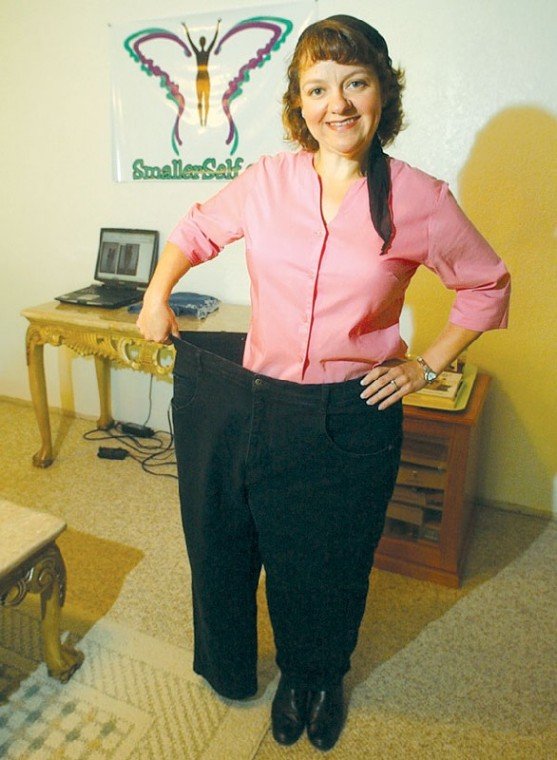The complications from her weight loss surgery have not always
been pretty, but Sherry Hollman cannot imagine going back to her
life the way it was two years ago.
At a petite five-foot-two, the Gilroy resident felt anything but
slight. She had reached 275 pounds and hit rock bottom.
The complications from her weight loss surgery have not always been pretty, but Sherry Hollman cannot imagine going back to her life the way it was two years ago.
At a petite five-foot-two, the Gilroy resident felt anything but slight. She had reached 275 pounds and hit rock bottom.
“I used to not go out very much because I was self-conscious of my weight,” said the 34-year-old stay-at-home mom. “I didn’t go to family functions and parties because I didn’t want people to compare me to what they had seen before. I wasn’t active. I was just too darn fat and too darn tired.”
Like Hollman, who had her surgery in January 2003, a growing number of Americans are going under the knife to shed pounds. Between 1993 and 2003, the field of gastric bypass surgery grew by more than 500 percent, from an average of 16,800 operations performed just over a decade ago to more than 103,000 in 2003, according to the American Society for Bariatric Surgery. The surgery is not without risks. As many as three in 1,000 people who undergo the surgery die from it, according to the American Medical Association, and those who do complete it successfully face a bevy of side effects from malnutrition and hair loss to chronic diarrhea and health problems brought on by rapid weight loss.
Still, as celebrities like singer Carnie Wilson, and “American Idol” judge Randy Jackson continue to tout their successes, American waist lines continue to expand and new patients continue to come forward. Twenty years ago, one in 200 people was considered morbidly obese, or 100 pounds or more overweight. As of 2000, one in 50 people had reached that level.
In the time since her surgery, Hollman has lost 150 pounds and dropped from a size 24 to a size 2 or 4, depending on the style of clothing she’s selected, and while she would do it over again in a heartbeat, the transition has not been without troubles.
Hollman underwent what is known as a Roux-en-Y gastric bypass surgery.
In this procedure, which is done under anesthesia, a patient’s stomach is made smaller as the surgeon divides the stomach into a small upper portion, commonly referred to as the pouch, and a larger lower portion, according to the online medical encyclopedia Medline Plus, a publication of the National Institutes of Health.
When the division is complete, the surgeon connects the pouch to a section of the small intestine, allowing food to travel only through the pouch rather than the larger portion of the stomach.
Finally, the surgeon reconnects the lower stomach section with the small intestine as well, aiding the absorption of vitamins and minerals by allowing pancreatic fluid and bile to mix with foods, the site said.
When patients emerge from surgery, they are kept on a liquid diet at first, but as their stomachs begin to heal, they are able to eat, just not like they used to, according to registered dietitian Lynn Kjelson of Hazel Hawkins Hospital in Hollister.
“They can eat very little in the way of processed foods, no concentrated sugars or sweetened foods, no carbonated beverages,” said Kjelson. “They need balanced proteins, fresh fruit, fresh vegetables and whole grains. It’s basically the stuff that’s on the normal food pyramid, but much smaller portions are tolerated.”
After surgery, Hollman’s body could tolerate just one quarter cup of food per sitting, and she had to be extremely careful about even that. One half teaspoon overboard could be the difference between feeling full and throwing up.
Then there was the dumping. Gastric bypass patients often absorb nutrients inefficiently and are unable to process foods fully after their surgeries. “Dumping” refers to the diarrhea that often accompanies these disturbances in the digestive system.
“I have malnutrition issues, malabsorbtion issues,” said Hollman. “I have blood work done every three months, and I have to maintain a very high-protein, low-carb diet. I have a handful of multivitamins a day, and I have to take things for hair loss. I’ve had to have plastic surgery (to get excess skin taken in), but I tell everyone, ‘I would have this surgery every year on the anniversary of the original just to maintain what I’ve gotten.”
At her lowest, Hollman said she had gotten beyond the point of caring about what she ate, reasoning she was going to be overweight one way or another.
She hit rock bottom when she realized she may not be there for her children later in life and became determined as she began thinking of them and of the future.
Over the years, Hollman had tried Atkins, Weight Watchers and even Fen-Phen, but the weight she dropped had always come back.
Hollman took her doctor’s advice and went through the entire screening process required to become a candidate for gastric bypass surgery.
Patients must not only obtain the support of their physician, but submit to an array of tests and scans, meet with a dietitian and see a psychologist for a thorough screening, said Kjelson.
“They are referred to the dietitian, basically, so they have an understanding of good nutrition habits, what to expect post-operatively and what to expect later on,” said Kjelson, who also screens patients to ensure they do not have a history of eating disorders.
Patients found to have eating disorders or certain psychological problems are not eligible for the surgery, and either Kjelson or the psychologist may reject patients for a variety of reasons from impulsiveness to lack of social support from family members, friends or medical professionals.
“Almost all the patients that come to me have researched the surgery for at least a year,” said Kjelson. “If they just thought of it, and they come to me, I ask them to research it a bit. If they’re open to it, I have them talk with (members of the Hazel Hawkins gastric bypass support group). I don’t want them to look at it as a diet. It isn’t. It’s a very serious surgery, and it’s a lifestyle change they have to be willing to accept.”
Hollman was more than willing. These days, she spends time riding bikes and playing outdoors with her children, ages 13 and eight. She said she’s glad for the time she’s been able to make up with them.
“I work harder every day to maintain my weight than I ever did, and every day I have to decide to do it again,” said Hollman, who can now stand in a single leg of the jeans she used to wear. “I kept one set of fat clothes because I wanted to remember where I came from. I never want to go back.”
For more information on weight control surgery, or if you have undergone surgery yourself and would like to talk, contact one of the South Valley’s local support groups. In Hollister, dietitian Lynn Kjelson leads the Hazel Hawkins gastric bypass support group on the third Thursday of every month from 7pm to 8pm in the hospital’s Gil Gallery. Sherry Hollman’s group meets the last Saturday of each month at 1pm in the Gilroy area. For more information, e-mail Su*****@*********lf.com.
The skinny on weight loss
Weight issues are not just cosmetic problems. Many doctors now classify morbid obesity as a disease, according to the American Medical Association, and the complications that go along with it form a seemingly endless list.
The body mass index, a measure of the body’s total fat content, is the best way to determine whether or not you would fall into the category of overweight or obese. A BMI of 18.5 to 24.9 is considered normal weight, whereas someone with a BMI of 25 to 29.9 is considered overweight. The term obese is used to describe anyone with a BMI of 30 or greater and morbidly obese applies to anyone with a BMI of 40 or more.
To check your own BMI, visit nhlbisupport.com/bmi/, and if you fall into the category of morbidly obese, talk with your doctor.












